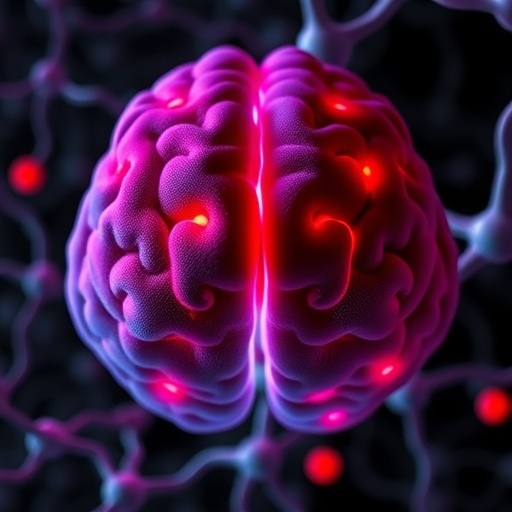
In the relentless quest to unravel the complex pathophysiology of Alzheimer’s disease (AD), a groundbreaking study has emerged revealing intricate details about the excitatory-inhibitory imbalances that characterize this devastating neurodegenerative disorder. Researchers Ranasinghe, K.G., Kudo, K., Syed, F., and colleagues have shed striking light on how amyloid-β and tau proteins distinctly disrupt neural circuits in patients with Alzheimer’s, offering potentially transformative insights into targeted therapeutic strategies. Published recently in Nature Communications, this pivotal research not only advances our understanding of AD’s molecular underpinnings but also challenges current paradigms about how circuit dysfunction progresses in the human brain.
Fundamental to normal brain function is the delicate balance between excitatory and inhibitory synaptic signaling. This equilibrium allows neural networks to maintain appropriate levels of activity, enabling cognition, memory formation, and behavioral regulation. In Alzheimer’s disease, a hallmark pathological feature involves the accumulation of amyloid-β plaques and neurofibrillary tangles composed of hyperphosphorylated tau. While the toxic effects of these protein aggregates have been extensively documented, their precise influence on excitatory and inhibitory neuronal populations—and how these effects diverge—has remained elusive until now.
Employing advanced neuroimaging techniques alongside electrophysiological analyses, the team meticulously examined brain tissue from AD patients. They identified that amyloid-β primarily associates with disruptions in excitatory neuron function. These excitatory neurons, usually responsible for propagating signals through glutamatergic neurotransmission, exhibit hyperactivity or, paradoxically, synaptic failure depending on the disease stage. Conversely, alterations in inhibitory neurons, which predominantly utilize gamma-aminobutyric acid (GABA) to temper circuit activity, were found to be more directly linked to tau pathology. This segregation of pathological influence suggests that amyloid-β and tau contribute to circuit dysfunction via distinct cellular mechanisms.
One of the most revelatory aspects of this study is the demonstration that excitatory-inhibitory imbalance is not a uniform phenomenon but rather manifests as disparate disruptions contingent upon the dominant pathological agent. Amyloid-β appears to induce excitatory neuron hyperexcitability early in Alzheimer’s progression, potentially precipitating synaptic loss and network instability. Meanwhile, tau pathology seems to degrade inhibitory interneuron structure and function, resulting in reduced inhibitory tone and thereby exacerbating neural network hyperactivity in later stages. These findings paint a dynamic and temporally evolving picture of neurocircuitry alteration in AD, emphasizing the differential vulnerability of neuronal subtypes.
The implications of these insights are profound. By distinguishing how amyloid-β and tau differentially undermine excitatory and inhibitory neurons, the research paves the way for precision medicine approaches. Therapeutic interventions might be custom-designed to target hyperactive excitatory circuits in the early phases of AD or to fortify inhibitory control mechanisms as tau pathology advances. This dual-pronged strategy could mitigate cognitive decline more effectively than uniform treatments addressing amyloid or tau in isolation.
Instrumental to achieving these conclusions was the utilization of cutting-edge tools such as patch-clamp electrophysiology and optogenetics, which allowed the researchers to assess synaptic properties and neuronal firing patterns with unprecedented granularity. These techniques enabled a dissection of how pathological proteins influence excitability and inhibition at the cellular and microcircuit levels, revealing nuanced deficits that conventional imaging modalities might have overlooked.
Moreover, the study integrated biomarkers from cerebrospinal fluid and postmortem brain analysis correlating molecular pathology with functional disruptions. This multimodal approach strengthened the causal links between amyloid-β, tau, and the observed excitatory-inhibitory dysregulation. Importantly, these findings also underscore the heterogeneity within Alzheimer’s disease, which could explain why some patients exhibit variable symptom severity and progression rates, possibly reflective of differential protein burdens and circuit vulnerabilities.
Another noteworthy outcome relates to the aberrant synchronization of neuronal populations in AD. The imbalance between excitation and inhibition leads to network-level phenomena such as epileptiform discharges and abnormal oscillatory activity, which have recently been implicated in accelerating cognitive impairment. The distinct roles of amyloid-β and tau in modulating these dynamics enhance our understanding of how pathological protein accumulation translates into large-scale network dysfunction observable in electroencephalographic recordings.
Beyond its clinical relevance, this work enriches the fundamental neuroscience landscape by elucidating the divergent pathways through which two hallmark AD proteins subvert circuit stability. It invites a reevaluation of experimental models that have predominantly treated amyloid and tau effects as additive rather than mechanistically distinctive. The study also champions the necessity to consider cell-type-specific pathologies in neurodegeneration, reinforcing the concept that interneurons—traditionally less emphasized—play a critical role in disease etiology.
Furthermore, the revelation that inhibitory interneuron impairment is specifically tied to tau pathology offers intriguing parallels with other tauopathies, such as frontotemporal dementia, suggesting potential commonalities in excitatory-inhibitory imbalances across neurodegenerative diseases. This cross-disease perspective could lead to broader therapeutic insights and foster the development of treatments beneficial beyond AD alone.
The research team also highlights the prospective utility of targeting synaptic proteins involved in inhibitory transmission for biomarker development. Given that tau-associated inhibitory dysfunction may precede overt neuronal loss, measuring changes in GABAergic markers or related synaptic components could enhance early diagnosis, opening windows for timely intervention.
As with all pioneering studies, several questions remain open. Understanding how the initial triggers for amyloid-β and tau aggregation set off these divergent excitatory and inhibitory effects, and the role of neuroinflammation and glial cell interactions in modulating these pathways, warrant further exploration. In addition, the translation of these findings into safe and effective treatments will necessitate rigorous clinical trials to validate targets and delivery methods.
In sum, the findings presented by Ranasinghe and colleagues dramatically advance the neuroscience field’s grasp of Alzheimer’s disease pathophysiology. By disentangling the distinct manifestations of excitatory-inhibitory imbalance attributable to amyloid-β and tau, this research proposes a nuanced framework for understanding, diagnosing, and ultimately treating this currently incurable disorder. As the global burden of dementia escalates, such breakthroughs offer a beacon of hope for patients, families, and clinicians worldwide.
Subject of Research: Excitatory-inhibitory imbalance associated with amyloid-β and tau pathology in Alzheimer’s disease.
Article Title: Distinct manifestations of excitatory-inhibitory imbalance associated with amyloid-β and tau in patients with Alzheimer’s disease.
Article References:
Ranasinghe, K.G., Kudo, K., Syed, F. et al. Distinct manifestations of excitatory-inhibitory imbalance associated with amyloid-β and tau in patients with Alzheimer’s disease. Nat Commun 16, 7957 (2025). https://doi.org/10.1038/s41467-025-62798-4
Image Credits: AI Generated
Tags: advanced neuroimaging techniquesAlzheimer’s disease researchamyloid-β and tau proteinscognitive decline in Alzheimer’selectrophysiological analyses in neuroscienceexcitatory-inhibitory imbalancemolecular mechanisms of neurodegenerationneural circuit dysfunctionneurodegenerative disorderspathophysiology of Alzheimer’ssynaptic signaling equilibriumtargeted therapeutic strategies





